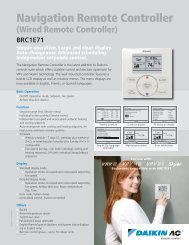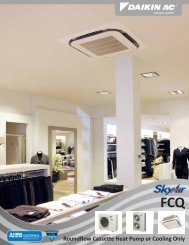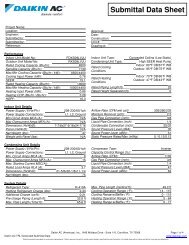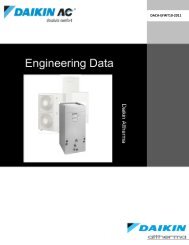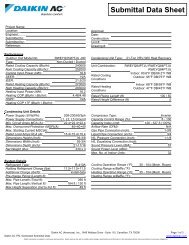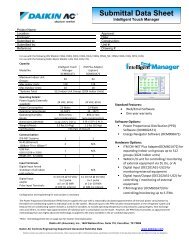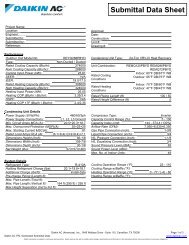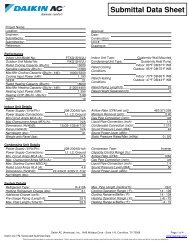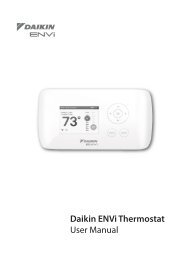INSTALLATION MANUAL - Daikin AC
INSTALLATION MANUAL - Daikin AC
INSTALLATION MANUAL - Daikin AC
- No tags were found...
You also want an ePaper? Increase the reach of your titles
YUMPU automatically turns print PDFs into web optimized ePapers that Google loves.
8. ADDITIONAL REFRIGERANT CHARGEWARNING• When leaving the unit with the power on, be sure toswitch with another person doing the installation or closethe front panel.8-1 Before adding refrigerant• Make sure the following work and inspection is complete, in accordancewith the installation manual.• Piping• Wiring• Airtightness test, Vacuum drying8-2 Checking the refrigerant tank• Check whether the tank has a siphon pipe before charging and placethe tank so that the refrigerant is charged in liquid form. (See the figurebelow.)Tank with siphon pipeThere is a siphonpipe inside, so thecylinder need not beupside-down to fillwith liquid.(Stand the cylinderupright when filling.)Other tanksStand the tankupside down andcharge.8-3 Adding refrigerantFilling after calculating the amount of refrigerant to add1. Calculate the amount of refrigerant to add as described in “Calculating the amount of refrigerant to add”in “7. PRECAUTIONS ON REFRIGERANT PIPING”.2. After the vacuum drying is finished, open valve A and charge the calculated amount of refrigerant throughthe service port for the liquid-side shutoff valve.3. Close valve A after charging is complete.Note: If all the refrigerant to be added cannot be charged using the above procedure, right-hand the procedurebelow and re-charge the refrigerant.Status of the shutoff valve and other valves when adding refrigerant• See “Shutoff valve operation procedure” in “7. PRECAUTIONS ON REFRIGERANT PIPING” fordetails on how to use the shutoff valve.(Refer to figure 29)1. R410A Tank (Siphon system) 5. Shutoff valve service port2. Measuring instrument 6. Gas line shutoff valve3. Valve A 7. Outdoor unit4. Indoor unit 8. Liquid line shutoff valveState of valve A and the shutoff valve Valve ALiquid line Gas lineshutoff valve shutoff valveBefore starting to charge the refrigerantClose Close CloseDuring charging of the refrigerantOpen Close CloseIf all the refrigerant could not be addedAdd refrigerant using the following procedure. See the “Service Precautions” plate attached to the ElectricalComponent Box lid on the outdoor unit for details on the settings for adding refrigerant.[Procedure]1. Close the front panel and turn on the power to all outdoor units and indoor units in the refrigeration system.2. Open the gas and liquid-side shutoff valves all the way and add the refrigerant. (Open valve A immediately after starting the compressor.)3. Once the appropriate amount of refrigerant is in, press the confirmation button (BS3) on the outdoor unit PCboard (A2P), and stop operation after adding the refrigerant.4. Close valve A after charging is complete.Status of the shutoff valve and other valves when adding refrigerant operation• See “Shutoff valve operation procedure” in “7. PRECAUTIONS ON REFRIGERANT PIPING” for details on how to use the shutoff valve.• Connect the service port (for charging refrigerant) inside the unit. When the unit is shipped from the factory,refrigerant is already charged, so be careful when connecting the charge hose.• After adding the refrigerant, do not forget to close the lid of the service port (for adding refrigerant).The tightening torque of the lid is 8.5~10.3ft·lbf.(Refer to figure 30)1. Gas line shutoff valve 2. Liquid line shutoff valve 3. Shutoff valve service port4. Indoor unit 5. Measuring instrument 6. R410A Tank (Siphon system)7. Valve A 8. Service port 9. (For adding refrigerant)10. Outndoor unitState of valve A and the shutoff valve Valve ALiquid line Gas lineshutoff valve shutoff valveBefore starting to charge the refrigerantDuring charging of the refrigerantClose Open OpenOpen Open Open9. POST-WORK CHECKSPerform the following checks after work is complete.(1) Drain pipe connection, removal of transport clasp →See “5. PRECAUTIONS ON <strong>INSTALLATION</strong>”.(2) Incorrect power supply wiring, loose screws →See “6-3 How to connect the power supply wiring”.(3) Incorrect transmission wiring, loose screws →See “6-4 Transmission wiring connection procedure”.(4) Incorrect refrigerant piping connections →See “7. PRECAUTIONS ON REFRIGERANT PIPING”.(5) Piping sizes, use of insulation →See : “7-2 Selecting piping material”.“7-6 Heat insulation of piping”.(6) Shutoff valve check →Make sure both the liquid-side and gas-side shutoff valves areopen.(7) Record of Amount of Refrigerant Added →Record it on “Record of Amount of Refrigerant Added” on the “ServicePrecautions” plate.(8) Measuring the insulation of the main power circuit →• Use a 500V mega-tester.• Do not use the mega-tester for weak currents other than 208/230V.(Transmission wiring)CAUTIONTo the pipe-layerAfter completing installation, be sure to open the valve.(Operating the unit with the valve shut will break the compressor.)10. TEST RUNThis unit is equipped with a crank case heater to ensure smoothstartup. Be sure to turn the power on at least 6 hours before operationin order to have power running to the crank case heater.WARNINGWhen leaving the unit with the power on, be sure to switchwith another person doing the installation or close the frontpanel.Precautions before turning the power on• Using insulating sheets, tape electric parts as described in the “ServicePrecautions” plate on the back of the front panel.• All indoor units connected to the outdoor unit operate automatically.Complete work on the indoor units in order to ensure maximum safety.10-1 Power On–Check Operation• Make sure to perform the check operation after installation.(If the air conditioner is operated using the indoor remote controllerwithout performing the check operation, the malfunction code “U3” isdisplayed in the indoor remote controller, and normal operation isdisabled.)• When making settings on the outdoor unit PC board (A2P) after turningthe power on, do not touch anything other than the push-buttonswitches and dip switches.(See the “Service Precautions” plate for the locations of the pushbuttonswitches (BS1-5) and dip switches (D1-1, 2) on the PC board(A2P).)English 12




